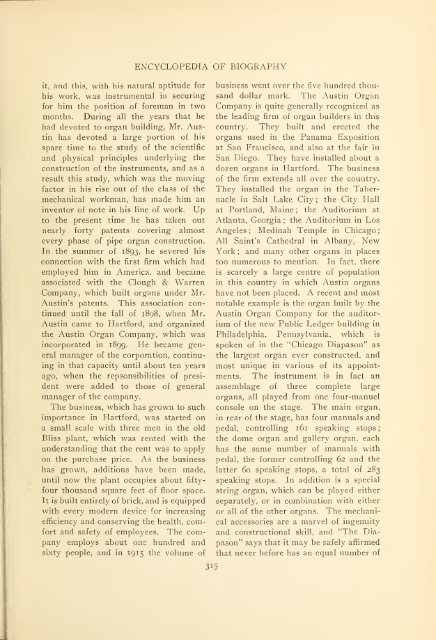Encyclopedia of Connecticut biography, genealogical-memorial ...
Encyclopedia of Connecticut biography, genealogical-memorial ...
Encyclopedia of Connecticut biography, genealogical-memorial ...
You also want an ePaper? Increase the reach of your titles
YUMPU automatically turns print PDFs into web optimized ePapers that Google loves.
it, and this, with his natural aptitude for<br />
his work, was instrumental in securing<br />
for him the position <strong>of</strong> foreman in two<br />
months. During all the years that he<br />
had devoted to organ building, Mr. Aus-<br />
tin has devoted a large portion <strong>of</strong> his<br />
spare time to the study <strong>of</strong> the scientific<br />
and physical principles underlying the<br />
construction <strong>of</strong> the instruments, and as a<br />
result this study, which was the moving<br />
factor in his rise out <strong>of</strong> the class <strong>of</strong> the<br />
mechanical workman, has made him an<br />
inventor <strong>of</strong> note in his line <strong>of</strong> work. Up<br />
to the present time he has taken out<br />
nearly forty patents covering almost<br />
every phase <strong>of</strong> pipe organ construction.<br />
In the summer <strong>of</strong> 1893, he severed his<br />
connection with the first firm which had<br />
employed him in America, and became<br />
associated with the Clough & Warren<br />
Company, which built organs under Mr.<br />
Austin's patents. This association continued<br />
until the fall <strong>of</strong> 1898, when Mr.<br />
Austin came to Hartford, and organized<br />
the Austin Organ Company, which was<br />
incorporated in 1899. He became gen-<br />
eral manager <strong>of</strong> the corporation, continu-<br />
ing in that capacity until about ten years<br />
ago, when the repsonsibilities <strong>of</strong> presi-<br />
dent were added to those <strong>of</strong> general<br />
manager <strong>of</strong> the company.<br />
The business, which has grown to such<br />
importance in Hartford, was started on<br />
a small scale with three men in the old<br />
Bliss plant, which was rented with the<br />
understanding that the rent was to apply<br />
on the purchase price. As the business<br />
has grown, additions have been made,<br />
until now the plant occupies about fifty-<br />
four thousand square feet <strong>of</strong> floor space.<br />
It is built entirely <strong>of</strong> brick, and is equipped<br />
with every modern device for increasing<br />
efficiency and conserving the health, comfort<br />
and safety <strong>of</strong> employees. The company<br />
employs about one hundred and<br />
sixty people, and in 191 5 the volume <strong>of</strong><br />
ENCYCLOPEDIA OF BIOGRAPHY<br />
315<br />
business went over the five hundred thousand<br />
dollar mark. The Austin Organ<br />
Company is quite generally recognized as<br />
the leading firm <strong>of</strong> organ builders in this<br />
country. They built and erected the<br />
organs used in the Panama Exposition<br />
at San Francisco, and also at the fair in<br />
San Diego. They have installed about a<br />
dozen organs in Hartford. The business<br />
<strong>of</strong> the firm extends all over the country.<br />
They installed the organ in the Taber-<br />
nacle in Salt Lake City ; the City Hall<br />
at Portland, Maine; the Auditorium at<br />
Atlanta, Georgia ; the Auditorium in Los<br />
Angeles ; Medinah Temple in Chicago<br />
All Saint's Cathedral in Albany, New<br />
York ; and many other organs in places<br />
too numerous to mention. In fact, there<br />
is scarcely a large centre <strong>of</strong> population<br />
in this country in which Austin organs<br />
have not been placed. A recent and most<br />
notable example is the organ built by the<br />
Austin Organ Company for the auditorium<br />
<strong>of</strong> the new Public Ledger building in<br />
Philadelphia, Pennsylvania, which is<br />
spoken <strong>of</strong> in the "Chicago Diapason" as<br />
the largest organ ever constructed, and<br />
most unique in various <strong>of</strong> its appointments.<br />
The instrument is in fact an<br />
assemblage <strong>of</strong> three complete large<br />
organs, all played from one four-manuel<br />
console on the stage. The main organ,<br />
in rear <strong>of</strong> the stage, has four manuals and<br />
pedal, controlling 161 speaking stops;<br />
the dome organ and gallery organ, each<br />
has the same number <strong>of</strong> manuals with<br />
pedal, the former controlling 62 and the<br />
latter 60 speaking stops, a total <strong>of</strong> 283<br />
speaking stops. In addition is a special<br />
string organ, which can be played either<br />
separately, or in combination with either<br />
or all <strong>of</strong> the other organs. The mechani-<br />
cal accessories are a marvel <strong>of</strong> ingenuity<br />
and constructional skill, and "The Diapason"<br />
says that it may be safely affirmed<br />
that never before has an equal number <strong>of</strong>

















